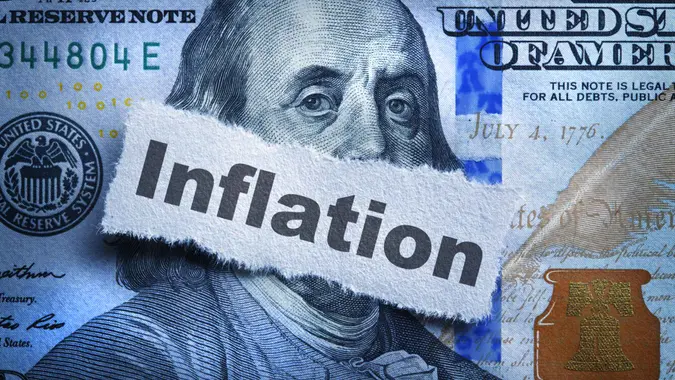Jeff Bezos Says All Decisions Are ‘Type 1’ or ‘Type 2’: Here’s How To Apply This to Your Finances

Commitment to Our Readers
GOBankingRates' editorial team is committed to bringing you unbiased reviews and information. We use data-driven methodologies to evaluate financial products and services - our reviews and ratings are not influenced by advertisers. You can read more about our editorial guidelines and our products and services review methodology.

20 Years
Helping You Live Richer

Reviewed
by Experts

Trusted by
Millions of Readers
If you’ve ever struggled to make smart financial decisions, you’re not alone. A Pew Research study found that only 52% of people feel confident in their knowledge of personal finance. The rest? Not so much.
But did you know that Jeff Bezos’ belief that all decisions are either Type 1 or Type 2 could help? Here’s what these decisions are and how they can apply to your finances.
What Are ‘Type 1’ and ‘Type 2’ Decisions?
According to one of Jeff Bezos’ shareholder letters, there are two main types of decisions:
- One-way doors (Type 1): These are “consequential and irreversible or nearly irreversible” decisions with long-term impact. They require methodological planning, careful thought and consultation. Like one-way doors, once the decision is made, there’s no going back.
- Two-way doors (Type 2): These are decisions with reversible consequences. Once made, you still have the option to turn back and make some changes for a different — hopefully, preferable — result. They don’t require as much deliberation, but should still be made with some consideration.
How Type 1 Decisions Apply To Finances
Type 1 decisions:
- Aren’t easily reversible
- Have long-term consequences (rather than short-term)
- Require a lot of time and resources to undo
So, how does this apply to your finances? Say, for example, you’re buying a home. Unless you’re paying in cash, this requires:
- Comparing multiple mortgage lenders and their interest rates
- Checking your credit (and potentially taking the time to improve it)
- Running the numbers to make sure you can afford the new loan payment with interest, insurance, taxes and any other related fees
- Maintaining steady employment for at least two years, according to The Mortgage Reports
- Saving up for a sizable down payment to boost your approval odds, potentially lower your interest rate and get you smaller monthly payments, according to Consumer Financial Protection Bureau (CFPB).
You’ll also want to make sure you’re financially and emotionally ready for the commitment. After all, most mortgages are either for 15 to 30 years, per CFPB. Even if you choose to sell your home before then, it will generally take time. Zillow found the average home takes 47 to 62 days to sell. You may also have to deal with closing fees and moving costs.
Other examples of Type 1 financial decisions include:
- Starting a business: You’ll need time to consider whether this is the best option for you. This means doing market research, consulting the experts (or existing stakeholders) and conducting a cost-benefit analysis. It may also mean having a long-term exit strategy.
- Taking out another large loan: Like with a mortgage, you’ll need to consider rates, terms, repayment amounts and other costs. If the new loan comes with a hefty monthly payment, ask yourself how this might impact your ability to pay off other debts or save for retirement.
How Type 2 Decisions Apply To Finances
Type 2 decisions:
- Are usually much easier to reverse
- Tend to have shorter-term consequences
- Don’t require as much time and deliberation
- Usually have a lower initial investment (whether that’s time or money)
- Can be adjusted on the go
Examples of Type 2 decisions in finances include:
- Adjusting your budget: You may find your income and expenses aren’t quite lining up, or that you want to make more room for your debts. This could mean making a short-term adjustment to your household budget. If it doesn’t work out, you can always try again next month or the month after.
- Trying a new financial app: There are plenty of personal finance apps out there. Some help you budget, while others automatically search for ways to cut down on expenses like subscription services. Even if you pay a little money, you can always cancel and try a new one later on.
Another Type 2 decision could be related to your investments. While this requires a bit more deliberation, and perhaps a professional consultation, you can switch up your investment allocations every so often.
For example, you might want to lower risk by taking on more bonds and fewer stocks. Or you might feel you’re ready to invest more aggressively — possibly in higher-risk, higher-return options. If it doesn’t pan out, you can reverse the changes later.
Just know that some investment-related decisions can have longer-term consequences or even derail your retirement plans (thus putting them more in line with the Type 1 category).
Say you open a traditional IRA at age 30 and contribute $7,000 every year with an expected 7% rate of return. Your balance at age 65 would be $967,658. This is a Type 2 decision because you really only have to decide to start — and keep — investing.
But what if you decide to stop contributing to that IRA for five or 10 years? Not only would you lose a lot in terms of compounding (and returns), but you could be delaying your retirement plan. With a Type 1 decision, you’re making the early decision to max out your account and to keep doing that for the long haul. You can change your mind, but not without potentially serious consequences.
 Written by
Written by  Edited by
Edited by 

























